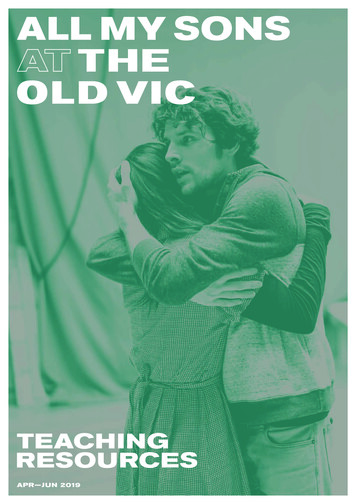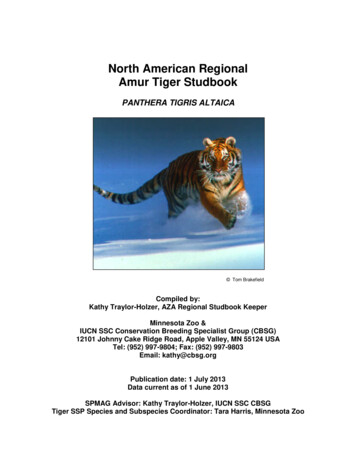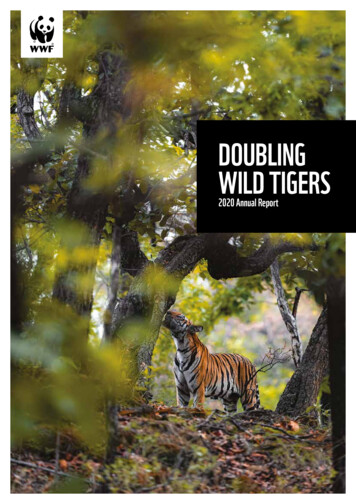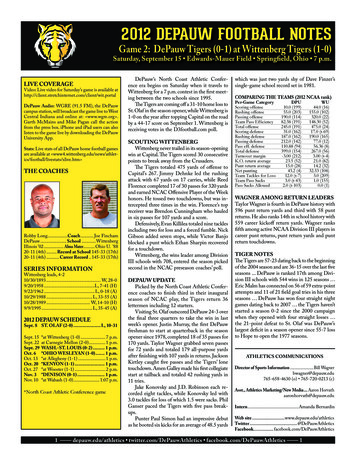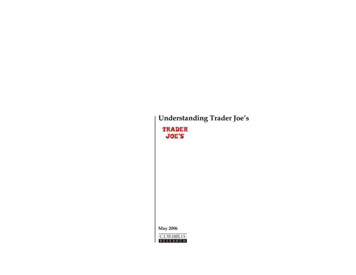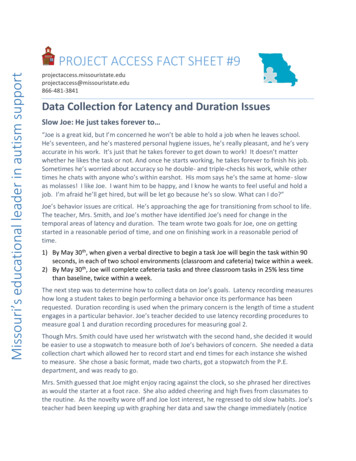
Transcription
LIONS AND TIGERS AND JOE EXOTIC:BIG CATS SUFFER IN TRAVELING ACTSINTRODUCTIONIn March 2020, the world got a glimpse of the dark underbelly of roadside zoos across America in Netflix’s TigerKing: Murder, Mayhem and Madness. The docuseries detailed events leading to big-cat breeder and abuser Joseph“Joe Exotic” Maldonado-Passage’s convictions for 17 counts of wildlife-related federal crimes, including killingfive endangered tigers and trafficking in endangered animals, and for hiring someone to murder the owner of anaccredited sanctuary that rescues big cats from roadside zoos and the entertainment industry. Tiger King exposedmillions of viewers to the worst practices of cub-petting operations, which continually churn out big-cat cubs, tearthem away from their mothers, and sell high-dollar public interactions with them. Those who survive the shortwindow of time in which they’re small enough to be handled may be illegally sold, given away, or killed. But thecub-petting industry has suffered a series of devastating blows, particularly as a result of PETA’s legal challenges, andthankfully, with heightened public scrutiny, its days are numbered.But cruelty to big cats extends far beyond the roadside zoos and shady individuals featured in Tiger King. Eachyear, often for months at a time, traveling exhibitors cart lions, tigers, and other big cats to circuses, fairs, and otherroadside attractions across the country. Over a dozen of these exhibitors operate in the United States,1 collectivelyimprisoning more than 80 of these animals and depriving them of everything that is natural and important to them.From the Serengeti plains to the birch forests of Russia, lions and tigers in nature control vast home territoriesdefined by complex social systems and familial bonds. Lion and tiger cubs stay at their mothers’ sides for years—andfemale lions remain with the pride into adulthood. Adept hunters, big cats may travel many miles in search of prey, agratifying pursuit that is essential to their survival and psychological well-being. Traveling displays deny big cats anyopportunity to engage in the behaviors that define them.PEOPLE FOR THE ETHICAL TREATMENT OF ANIMALS 1
Through violence and intimidation, trainers break the spirits of the big cats they force to perform, stripping themof their essence and leaving them a shell of their natural selves. The allure of these displays—the control and tamingof wild animals—relies on this abuse and promotes and reinforces dangerous beliefs about human supremacy anddominance over nature and animals. The continued exploitation of big cats in traveling displays threatens not onlythe individual animals forced to perform demeaning, confusing tricks under the threat of violent punishment but alsothe entire species they represent to audiences that fail to see them for who they are.TRAVELING EXHIBITS FUELED BY JOE EXOTIC AND THE CUB-PETTING INDUSTRYOne question rarely asked of traveling exhibitors is how an animal winds up in a cramped trailer, headed down theinterstate to a performance in the first place. The answer is closely guarded by the industry, and poor regulatoryoversight makes it difficult to verify where traveling exhibitors obtain big cats and other animals. But the fingerprintsof Maldonado-Passage and other Tiger King figures can be found all over circuses and other traveling animal acts.For many years, Joe Exotic had a traveling magicshow act that included wild animals, and he alsosold photo ops with tiger cubs at regional malls.His estranged former business partner, Jeff Lowe,took a page from his book and opened up mallexhibits to pimp out baby exotic animals as photoprops, like the tiger cub pictured here.Culpepper & Merriweather Circus owner Trey Keyis seen here holding a prod and forcing Francis thelion and Delilah the tiger to perform meaninglesstricks. In 2008, Delilah lost three cubs she gavebirth to while touring—two died within days,and the lone survivor was seized by the federalgovernment after he was found in the cab of asweltering truck.Disgraced exhibitor Doug Terranova has supplied tigers and otheranimals to the Carden International Circus, Shrine circuses, and theCulpepper & Merriweather Circus, as well as fairs across the country.In 2019, the U.S. Department of Agriculture (USDA), which regulatesanimal exhibitors, revoked his exhibitor’s license for “willful, repeated,and prolonged violations” of the Animal Welfare Act.2 He also has closeties to Maldonado-Passage: Terranova served as Maldonado-Passage’srunning mate during the latter’s failed 2016 presidential campaign andclaims to have obtained a dozen big cats from Maldonado-Passage andfellow Tiger King subject Bhagavan “Doc” Antle over the years.3 He isalso involved with the misleadingly named National Animal WelfareAssociation, which promotes traveling tiger acts and lobbies againstanimal protection legislation.4Before the 2008 circus season, Culpepper & Merriweather Circus ownerTrey Key boarded sibling tigers Solomon and Delilah—both of whomare still being forced to perform with the circus today—as well as alion named Francis at Terranova’s facility in Kaufman, Texas. Terranovaapparently failed to separate the cats, and in May 2008, while on tour,Delilah gave birth to three cubs presumably fathered by her brother.Within days, two of the inbred cubs died. In August, the lone survivor,named Tubbs, was confiscated by the USDA after he was found inthe cab of Terranova’s truck at the Iowa State Fair.5 The temperaturein the truck—which had no air conditioning—was over 89 degreesFahrenheit.6 Tubbs was underweight and had skin abrasions from anill-fitting harness and a wound near his eye.7 A USDA administrativelaw judge found that Key “demonstrated a shockingly cavalier attituderegarding the health and safety of animals” and suspended the circus’slicense.8While this instance of inbreeding could have been accidental, thecub-petting industry is notorious for unscrupulous breeding practices.PEOPLE FOR THE ETHICAL TREATMENT OF ANIMALS 2
This liger (left)—the hybrid offspring of a male lion and a female tiger—is part of a traveling display exhibited by Gregg Woody, who has shuttledhundreds of big cat and bear cubs around the country in his dealings with key players in the abusive cub-petting industry, including Joe Exotic.Ryan Easley, pictured above (right) forcing tigers to perform in a show at the Circus World Museum, reportedly bought at least a dozen tigers fromJoe Exotic and acquired two others from Bhagavan “Doc” Antle—a notorious big-cat cub exploiter who treats cubs as props and then sometimesdiscards them when they’re no longer profitable.Breeders often selectively breed big cats for specific physical traits, such as the recessive white or golden color morphs,which can have disastrous consequences for an animal’s health and well-being. The initial population of whitetigers in the U.S. could be traced to a single individual who was bred to his own daughter, while the current U.S.population stems from crossbreeding two tiger subspecies.9 To preserve the recessive trait that is responsible for theirwhite coats, white tigers—who are commonly used in traveling acts—are highly inbred, which can lead to increasedsusceptibility to disease, premature death, stillbirth, and debilitating deformities, such as cleft palates.10 Big-cathybrids are also at high risk for genetic defects.11 Ligers (the result of breeding a female tiger with a male lion—twoentirely different species who do not cross paths in nature) can grow so large that their organs cannot sustain theirown weight.12 Roadside zoos and backyard breeders such as those featured in Tiger King breed suffering into big cats,and that suffering is exacerbated by a life of exploitation, often at the hands of traveling exhibitors.Maldonado-Passage told PETA that Ryan Easley (aka Ryan Holder)—who owns ShowMe Tigers; is planning to open a roadside zoo in Hugo,Oklahoma, called Growler Pines Tiger Preserve; and exhibits tigers at theCircus World Museum, Shrine circuses, and the Carden circus, amongothers—bought at least a dozen tigers from his Greater WynnewoodExotic Animal Park (G.W. Zoo) and boarded tigers there when theyweren’t traveling for the circus. In 2019, Easley obtained two 8-month-oldtigers—Jade and Amara—from Antle while performing at Circus World.13These tigers were exploited on Antle’s watch from early on, and once theywere too old to be used as photo props, he sentenced them to a life ofdemeaning circus performances under threat of the whip.Roadside zoosand backyardbreeders such asthose featured inTiger King breedsuffering intobig cats.In 2012, the now-defunct Ringling Bros. and Barnum & Bailey Circus purchased eight tigers from MaldonadoPassage. Before arriving at Ringling, they were held by the Carden International Circus.14 For Ringling exhibitorslike big cat trainer Alexander Lacey, who toured with the circus until its final show in 2017, animal exploitation isa family affair. His mother, Susan Lacey, trained and presented tigers for the Hawthorn Corporation, a notoriousbreeder, dealer, and exhibitor. Dozens of tigers—including many juveniles—died on Hawthorn’s watch before it wentout of business in 2017.15PEOPLE FOR THE ETHICAL TREATMENT OF ANIMALS 3
One of Ringling’s former elephant trainers, Terry Frisco, and his family run a traveling big-cat show called TigerEncounter that appears at fairs with tigers exhibited by his daughter, Felicia Frisco. Felicia also exploits big cats toboost her social media following, frequently featuring a white tiger and a white lion in TikTok videos. According toresearch by Big Cat Rescue, the lion, named Shaka, appears to have been bred by Tiger King subject and former drugkingpin Mario Tabraue of the Zoological Wildlife Foundation. Like other big cats born at Tabraue’s facility, Shakawas likely torn away from her mother early on and used for cub-petting interactions. She was then apparently used ina film production and passed among various Florida-based exhibitors before landing in the Friscos’ custody aroundFebruary 2019—just months after her birth, when she should still have been by her mother’s side.16 But the Friscos’ties to the cub-petting industry don’t end with Shaka—Felicia Frisco also considered Maldonado-Passage and Antleclose friends. Both of them have defended her from public scrutiny of her exploitation of big cats.Maldonado-Passage also had his own traveling show, which he kept supplied with tiny cubs by constantly breedingbig cats at his roadside zoo in Oklahoma. Cubs were torn away from their mothers immediately after birth and soonafterward taken to malls and fairs across the United States to be used as lucrative photo props. In 2015, MaldonadoPassage was cited by the USDA for failing to provide a 19-day-old tiger cub—who was too young even to regulate hisown body temperature—with a secondary heating or cooling method for climate control while being exhibited at theMississippi Valley Fair in Iowa.17Ultimately, Maldonado-Passage’s ties to circuses and traveling acts helped secure the roadside zoo operator’s downfall.In October 2017, Key (of the Culpepper & Merriweather Circus) paid Maldonado-Passage 5,000 to house Francis,Solomon, and Delilah at G.W. Zoo. A worker at the facility testified that Maldonado-Passage used a shotgun tokill five healthy tigers in order to make room for Key’s big cats.18 Maldonado-Passage is currently serving a 22-yearsentence in federal prison for these and other crimes, including trafficking in endangered animals and two counts ofmurder-for-hire.COMPLIANCE COERCED THROUGH ABUSE AND PUNISHMENTTigers, lions, and other big cats don’t leap through hoops of fire, balance on their hind legs, or perform otherdangerous stunts because they want to—they engage in these unnatural behaviors under the threat of violence andVicenta Pages, pictured here intimidating big cats who are displaying defensive and fearful body postures, was once dragged by the leg across acircus ring by a tiger in front of schoolchildren at a fair. She smacked and whipped the tiger 10 times before her partner intervened and viciouslywhipped the animal in the face 23 more times, causing the tiger to let go of her leg.PEOPLE FOR THE ETHICAL TREATMENT OF ANIMALS 4
physical punishment. USDA regulations prohibit training with physical abuse,19 but the agency does not actuallymonitor training, which occurs behind closed doors and out of the public eye. In one of the most barbaric incidentscaught on film by a PETA eyewitness, disgraced former big-cat trainer Michael Hackenberger—who supplied animalsfor circuses in Canada—whipped a tiger named Uno approximately 20 times in a row, causing him such traumathat he emptied his anal sacs in fear. Hackenberger matter-of-factly stated that he “like[s] hitting [Uno] in the face”and uses his whip to carve his initials into the animals’ sides. In a 2017 investigation by the Humane Society of theUnited States, Ryan Easley (of ShowMe Tigers) was documented violently whipping tigers during training sessions.He reportedly whipped one animal over 30 times in less than two minutes.While the worst violence occurs in secret, the pain, force, and fear used to dominate big cats plays out on stage andis readily observable to anyone willing to look beyond the loud music and bright lights. When performing in front ofan audience, exhibitors keep their weapons close at hand, using them on the animals or cracking them on the floor,a constant reminder of the painful consequences of breaking routine.20 But no amount of training or physical abusecan overcome the instincts of tigers or lions, who will try to defend themselves as best they can—using their teeth andclaws. In such instances, trainers’ reactions are swift and merciless.At a 2017 Shrine circus performance in Florida, which featureda tiger act supplied by the now-defunct Hawthorn Corporation,an eyewitness documented handlers jabbing a tiger withpoles from outside the ring after the animal apparently brokeformation during a performance, causing the tiger to growl andspin in agitation. In 2016, stunned fairgoers observed trainerswhip a tiger named Gandhi in the face 33 times after handlerVicenta Pages used her knee to push him toward a hurdle andhe pulled her to the ground.21 Pages was filmed again proddingand whipping lions and tigers at the Tangier Shrine Circus in2020, as the cats frantically tried to escape. During the 2017Martin County Fair in Florida, a tiger bolted in fear after trainerJuergen Nerger—who, with his wife, Judit, operates Nerger’sLion and Tiger Show and carts animals to fairs and circusesacross the country—repeatedly “jab[bed] him in the throat witha stick” and “[hit] him in the face,” according to a witness.22Brian Franzen, who exhibits big cats at the Loomis Bros. Circusand Shrine circuses, has said he sprays cayenne pepper in tigers’eyes and noses when they refuse to obey his commands.23During a performance with the now-defunct HawthornCorporation, this tiger flinched and cowered in fear of thetrainer, who was wielding a prod and whip to intimidate andcoerce the animals into performing unnatural and confusingtricks. Anyone who looks beyond the bright lights and musiccan see that this is a terrified, abused individual.Fearing such violence, big cats are often reluctant to enter the performance ring, so in an attempt to force themon stage, workers may jab them aggressively with prods. Once in the ring, their body language conveys fear anddefensiveness.While performing, big cats often hunch their backs, lower their heads, and pin their ears back, all signs of fear orsubmission. In the Tangier Shrine Circus video mentioned above, the cats growl—a defensive reaction—several timesbefore finally bolting. Displaced aggression toward other cats, also apparent in the Tangier Shrine video, is commonand exacerbated by extreme crowding and a lack of escape routes while in transport cages and on stage.24 Big cats’PEOPLE FOR THE ETHICAL TREATMENT OF ANIMALS 5
Judit and Juergen Nerger, who cart tigers to county fairs and circuses all across the country, have been cited by the USDA for confining tigers tocages like these—so small that they can’t stretch to their full height or even sit upright.anxiety about performing is further illustrated by the fact that their rate of stereotypic pacing behavior—which isassociated with frustration, stress, agitation, and lack of mental stimulation, depending on the situation25—peaks inthe hour preceding a show.26Not only do abusive training methods cause psychological and physical harm, the tricks themselves can also bepainful, uncomfortable, and frightening for the cats. Typical stunts performed in circuses and other shows involveunnatural postures and movements that are rarely seen in the wild because of the strain they place on the body.27Performing animals forced to stand on their hind legs for long periods, for example, become susceptible to arthritis.28Leaping through flaming hoops, another standard trick in circuses, is terrifying and dangerous for big cats, who arenaturally afraid of fire. During a Russian circus performance, a tiger fell unconscious, convulsed, and emptied herbowels after being forced to jump through several hoops of fire. Horrified spectators watched as trainers dragged heraway by the tail.29DENIED ANY SEMBLANCE OF A NATURAL LIFEIntensive Confinement to Cramped Transport CagesIn their natural habitats, tigers and lions roam territories of up to 500 square miles.30 Their environment is spatiallycomplex and dynamic, which exercises not only their muscles, but also their minds as they make choices andexperience a sense of purpose while navigating through dense vegetation or across plains or while climbing trees insearch of prey and other resources.31 Big cats used in traveling acts, in stark contrast, are kept in close confinement formost of their lives, spending up to 99% of the time they are on the road—which can be up to 11 months a year—incramped transport cages.32 These cages, typically kept in a trailer during transport, can be as small as 24 square feet, afraction of the size of a parking space.33 For adult big cats, who can be nearly 10 feet long and weigh more than 500pounds,34 transport cages barely offer enough room for them to stand up and turn around, much less any significantfreedom of movement. Traveling big-cat exhibitors commonly receive citations for failing to meet minimum spacerequirements. In June 2021, the USDA cited Adam Burck, a big-cat exhibitor who supplies animals to the JordanWorld Circus and others, because he was storing four tigers in travel cages like equipment for at least 15 months. Theinspector found the animals confined to the cramped cages inside a stiflingly hot barn that was crawling with maggotsand had a rancid odor.35 Burck even has a written policy stating that his cats must be in transport cages “at all times”except when performing.36 The Nergers have been cited by the USDA for confining tigers to cages so small that theycouldn’t stretch or even sit upright.37 Similarly, trainer Brunon Blaszak has received at least seven citations concerningspace requirements, including ones for keeping a tiger in a cage in which he couldn’t stand up without hitting hishead and keeping tigers in transport cages for days at a time.38 In less than four years, from 2006 to 2010, Julius VonPEOPLE FOR THE ETHICAL TREATMENT OF ANIMALS 6
Uhl, who exhibited big cats at circuses, fairs, and other events, was cited at least 18 times for failing to meet minimumspace requirements.39 In one instance, a USDA inspector noted, “These enclosures are so small that the animalscontained don’t even have enough room to exhibit stereotypical signs of lack of space, such as pacing.”40 As a result ofhis repeated defiance of regulations, in 2010, the USDA finally confiscated six tigers and four lions from him.41Some exhibitors justify the near-constant confinement to transport cages by claiming that training and performancesessions provide enough exercise and time outside the cages.42 But the truth is that big cats typically perform forjust six to eight minutes per show, and their time in the ring can hardly be considered exercise. In a typical bigcat routine, the animals are forced to spend much of their time sitting still on pedestals and the rest performingunnatural tricks. And for some, being caged is the act: In a magic trick for the UniverSoul Circus, exhibitor MitchelKalmanson pressed tigers into hidden compartments of small cages, suspended them up in the air, and then madethem “appear.” When not performing, they were kept in aconverted semi-trailer. On two separate occasions in 2013,Kalmanson was cited for failing to offer the animals used inhis act any opportunity to exercise or make normal posturaladjustments.43Even when exercise pens are provided, they are usually small,barren enclosures in parking lots crowded with multiplecats or only provided on a rotational basis.44 In one studyin which tigers used by Ringling Bros. were given unlimitedaccess to an exercise pen for 72 hours, half of them exhibitedpacing behaviors more than 10% of the time—one individualpaced for 77.5% of the time—indicating “unacceptablycompromised” welfare.45 Pacing is often seen in animalsexperiencing chronic stress, deprivation, or psychologicaldistress. This demonstrates that the size and complexity of thepens are insufficient and that the long stints of confinementto transport cages are so damaging that they cannot bemitigated by merely providing cats with a slightly larger cage.A lack of adequate exercise and stimulation can cause obesityand behavior indicative of frustration, such as apathy.Incompatible Social GroupingsBig cats used in traveling acts are housed in highly abnormalsocial groupings that contradict their territorial instincts.While tigers have long been considered solitary in a naturalsetting, recent evidence has shown that they may prefer socialinteraction with one other cat in captivity.46 Living in groupslarger than two individuals and having close neighboringtigers, however, has been shown to induce stress-relatedbehavior, fighting, and pacing.47 Traveling acts do not havethe space to provide separate accommodations for eachtiger or pair away from other cats, forcing them to live inIn a magic trick for the UniverSoul Circus, exhibitor MitchelKalmanson crammed tigers into the hidden compartments ofsmall cages, suspended them up in the air, and then made them“appear” for screaming crowds. Kalmanson has been repeatedlycited for failing to offer the animals in his act any opportunity toexercise or make normal postural adjustments.In traveling acts, big cats, who are driven by territorial instincts,are forced to live in close proximity to their cagemates withoutany means of avoiding each other, and the cramped quarterscan induce stress-related behavior and fighting. Exhibitor BrianFranzen crammed the six tigers pictured here into a small truckto be moved from the travel trailer to the performance ring,offering no place for them to retreat from conflict.PEOPLE FOR THE ETHICAL TREATMENT OF ANIMALS 7
This tiger, named King, had been on tour in a circus with the now-defunct Hawthorn Corporation until he was returned to a cramped cage on aconcrete slab at the exhibitor’s animal housing site because he wasn’t eating. Over a week later, he still had not been evaluated by a veterinarian,and the USDA documented his poor, emaciated condition.close proximity to each other with no means of escape or places to hide. To move tigers from the travel trailer to theperformance ring, Brian Franzen uses an even smaller transport truck, cramming as many as half a dozen tigers into acage that offers no place to retreat during conflicts.Severe crowding and incompatibility can be deadly to big cats: A tiger owned by Vazquez Bros. Circus, which hadpreviously been cited twice by the USDA for failing to meet minimum space requirements for tigers,48 was killed andnearly decapitated by her four cagemates in 2008 after being left overnight with them in a small cage.49 Even after thishorrific incident, Vazquez Bros. was cited because it was still keeping five tigers in a cage half the size of a semi-trailer.50Inappropriate Feeding and Inadequate NutritionIn nature, tigers spend most of their time looking for prey, traveling efficiently and purposefully, as if using amental map of their territories.51 To a tiger, hunting is more than ameans to find food—it is psychologically fulfilling, it reinforces a senseof accomplishment, and it promotes positive feelings, improving mood,perception, memory, and attention.52 It also improves their physicalstrength. In recognition of this crucial aspect of big-cat welfare, reputablecaptive wildlife facilities, such as those accredited by the Global Federationof Animal Sanctuaries and the Association of Zoos and Aquariums (AZA),maintain enrichment programs that encourage tigers and other big catsto engage in simulated hunting, stalking, and foraging behaviors.53,54 Incontrast, traveling exhibitors deny big cats any opportunity to engage inTo a tiger,hunting is morethan a means tofind food—it ispsychologicallyfulfilling.these important species-specific types of behavior, disregarding the very essence of their being.PEOPLE FOR THE ETHICAL TREATMENT OF ANIMALS 8
As part of a properly formulated and complete diet, wholecarcass feeding can play an important role in promoting speciesappropriate behavior in big cats in captivity.55 In one studyconducted at three AZA facilities, carcass feeding decreased thenumber of abnormal repetitive behaviors observed off exhibit.56These feeding methods are nearly impossible to implement whileon the road, where a lack of consistent access to reliable foodsources often leaves exhibitors no choice but to take whatevermeat is available.57 For large carnivores, the psychological tollof an unnatural feeding regimen can be profound, and thisinconsistency—combined with traveling exhibitors’ reliance onemployees with no training in animal nutrition or husbandry—When they’re not being forced to perform or held intransport crates between shows, big cats used in travelingcan have serious implications for a big cat’s physical well-beingacts are typically housed in uncomfortable cages inand increases the risk of illness and malnutrition.58 For example,trailers like this one. They have no room to exercise orclimb, and they spend most of their time relegated toa lion cub owned by Mitchel Kalmanson, whose list of animalarena basements and parking lots. For these animals,welfare violations includes inappropriate feeding, died oftravel is a daily fact of life.metabolic bone disease, caused by a calcium-deficient diet.59A poor diet combined with a lack of exercise leaves big cats used in traveling acts at higher risk of joint and spineconditions, difficulties regulating their body temperature, and obesity, which can cause heart and organ problems.60A Dangerous, Demanding Life on the RoadStress during transport is a well-known problem in animal welfare, and big cats face unique challenges on the road.61During the performance season, animals may be traveling several times a week or even daily, exposed each time tostressful circumstances such as sleep disruption, disordered eating and drinking, human handling, temperature andmotion changes, noise, and close confinement.62 Tigers in one study transported for as little as 30 minutes had arespiration rate that was at its highest 10 minutes after being released and stress hormone levels up to 480% abovenormal for up to 12 days after their ride, suggesting that transport stress continues long after the experience is over.63Loading and unloading from the transport cage and trailer—perhaps the most stressful aspect of traveling—cancause a tiger’s body temperature to rise.64 This is of particular concern, as felines are sensitive to temperature changesand have a limited ability to sweat, instead relying on panting, shade, and immersion in water to regulate their bodytemperature.65 Close confinement and extreme crowding, combined with poor ventilation in transport trailers,contribute to fatal incidents in which big cats have died of heatstroke while traveling. In July 2004, a lion namedClyde—who was being transported across the Mojave Desert in a Ringling Bros. boxcar—died after reportedlynot being checked on or given water in six hours as temperatures exceeded 100 degrees Fahrenheit. The managerreportedly refused to stop because they were running late.66 Ringling had been cited by the USDA in 2000 for asimilarly tragic story, in which two tigers injured themselves trying to escape from a hot boxcar.67Temperature management is a factor at the performancesite as well. A common traveling act setup in a parking lotoffers little to no shade and no climate control. Havingaccess to a pool has been found to be the most importantfactor associated with good tiger welfare,68 but a pool isalmost never offered to big cats while on tour. Jordan WorldClose confinement andextreme crowding contribute to fatal incidentsin which big cats have died ofheatstroke while traveling.PEOPLE FOR THE ETHICAL TREATMENT OF ANIMALS 9
Circuses haul tigers around in trailers for months on end in all weather extremes. These tigers, panting heavily, apparently from heat stress, have noway to cool down. Without access to a pool, they sit in cramped transport cages with no relief.Circus was cited for keeping a tiger named Dutchess in a poorly ventilated trailer with no water in temperatures over95 degrees Fahrenheit, after having been cited just one week earlier for failing to provide two big cats with shade insimilar temperatures.69Big cats—whose hearing is about five times better than that of humans70—are very sensitive to the unending noisethat comes with transport and exhibition, whether being hauled around
took a page from his book and opened up mall exhibits to pimp out baby exotic animals as photo props, like the tiger cub pictured here. Culpepper & Merriweather Circus owner Trey Key is seen here holding a prod and forcing Francis the lion and Delilah the tiger to perform mean
